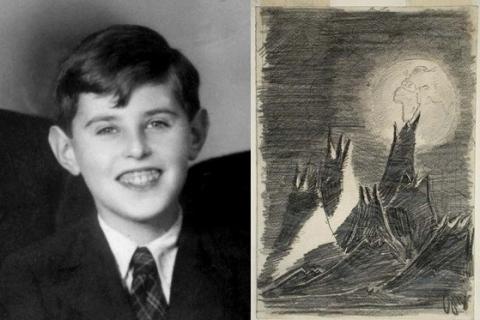Petr Ginza's archive is now in Yad Vashem
Born in Prague on February 1, 1928, to a Jewish father and Christian mother, Ginz was a gifted and imaginative child. By the time he was a teenager, he had written novels inspired by Jules Verne, composed essays and poems, and created intricate illustrations and maps. His intellectual curiosity and creative spirit flourished despite growing Nazi restrictions on Jewish life in Czechoslovakia.
In 1942, following Nazi racial laws that excluded Jews from public education, Ginz was deported to the Theresienstadt ghetto. There, he became the editor of Vedem (“We Lead”), an underground magazine produced by teenage boys imprisoned in the ghetto. He wrote stories and articles, drew sketches, created a Czech-Esperanto dictionary from memory, and meticulously documented his experience in a diary. One of his most iconic works from that time, the pencil drawing “Moon Landscape,” imagined Earth as seen from the surface of the moon—a powerful expression of escape and perspective amid horror.
In September 1944, at the age of 16, Ginz was deported to Auschwitz-Birkenau, where he was murdered in the gas chambers. His younger sister, Hava Ginz-Persburger, also interned in Theresienstadt, survived the Holocaust and dedicated her life to preserving his memory. In 2007, she published The Diary of Petr Ginz 1941–1942, a moving collection of his journal entries and original artwork.
The remarkable story of Petr Ginz re-entered the public eye in 2003 when Ramon, Israel’s first astronaut, took a copy of “Moon Landscape” aboard the Columbia mission. After the shuttle tragically disintegrated upon re-entry, the drawing became a symbol of resilience and remembrance. That attention helped uncover a long-forgotten archive.
Unbeknownst to the Ginz family, Petr’s original writings, sketches, and personal items had been packed into boxes and left in an attic in Prague for decades. After being inherited by a neighbor and later sold with the contents of a house, the materials remained untouched until renewed public interest following the Columbia disaster prompted the homeowner to recognize their significance.
Upon discovering the archive, Yad Vashem officials contacted Hava Ginz-Persburger in Israel. “For her, the collection was a tangible sign of life from her late brother,” said Eliad Morah-Rosenberg, chief curator of art at Yad Vashem. “She was determined to bring it home.”
With Yad Vashem’s support, Hava negotiated with the Czech homeowner—who had demanded a high price—to secure the return of the materials. The notebooks, letters, illustrations, and photographs were transferred to Israel and kept in Hava’s care. In her will, she instructed that the archive be donated to Yad Vashem upon her death, so that it could be preserved and shared with the public.
This week, ahead of Holocaust Remembrance Day, her daughter Tamar Tzemach-Marom fulfilled that wish. In an emotional handover ceremony, she delivered the archive to Yad Vashem, ensuring that the legacy of her uncle and her mother’s mission to protect it would live on.
“This collection offers an unparalleled, deeply personal testimony of a boy’s creativity, courage, and unbreakable spirit,” Morah-Rosenberg said. “Even in the darkest days, Petr planned his studies, set goals for his writing and art, and nurtured hope for the future.”
The archive includes dozens of handwritten notebooks, early issues of Vedem, Petr’s Czech–Esperanto glossary, and detailed maps and illustrations—some in color. Family letters between Petr and Hava, rare photographs of their childhood in Prague, and school portraits of classmates who were later killed in the Holocaust add depth to an already powerful narrative.
Tzemach-Marom, who lives in southern Israel, said her mother kept Petr’s diary close throughout her life, seeing it as a direct link to the brother she lost. “But she also knew that once she was gone, these items belonged in a place dedicated to preserving memory,” she said. “It was her final wish.”
Reflecting on the present moment, she added, “We are a fractured people, and Petr’s diary reminds us that strength is never guaranteed. We must unite around our core values, document our experiences faithfully, and serve as a light unto the nations.”
Yad Vashem plans to feature the newly acquired archive in a special spring exhibition and will include key pieces in a major upcoming display titled Living Memory: Between Past and Future, opening this September. The exhibit will highlight rare Holocaust-era artifacts and explore the enduring impact of creativity, identity, and resilience in times of persecution.
“Every page of Petr’s notebooks breathes with youthful curiosity and unwavering hope,” said Morah-Rosenberg. “His story—and these precious documents—will inspire generations to come.”
Anat Lev Adler

